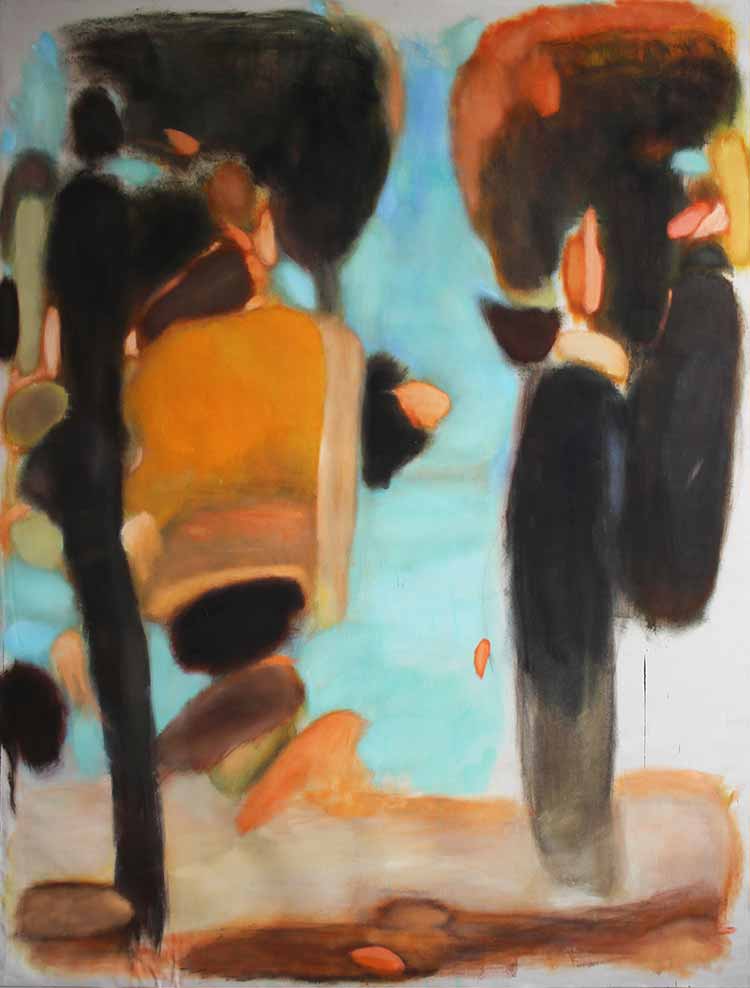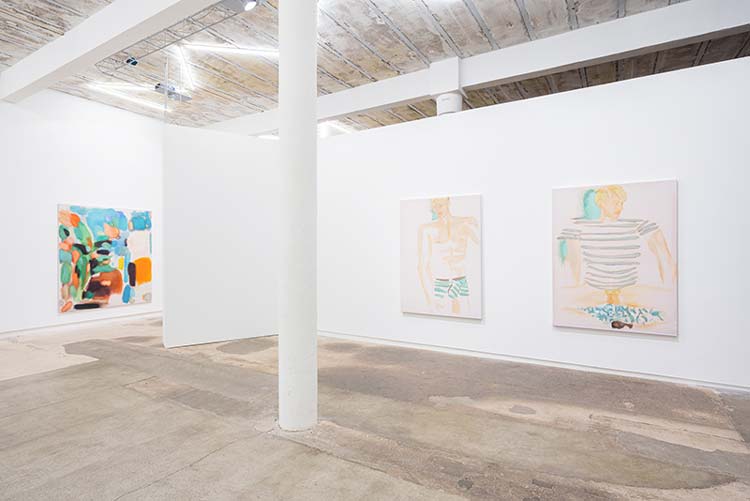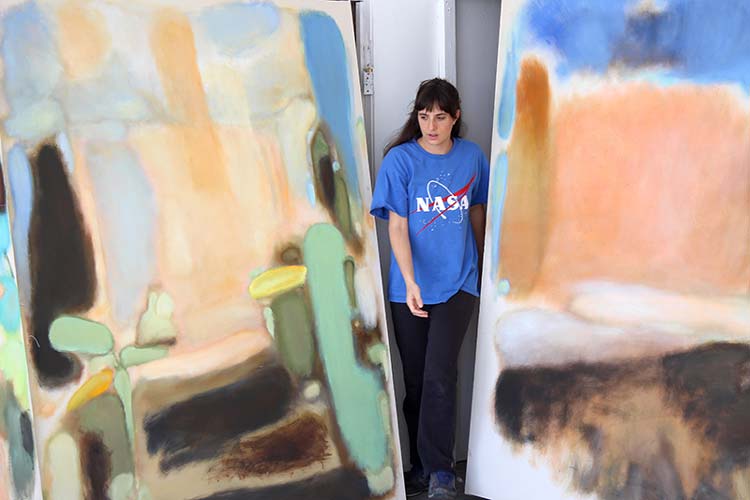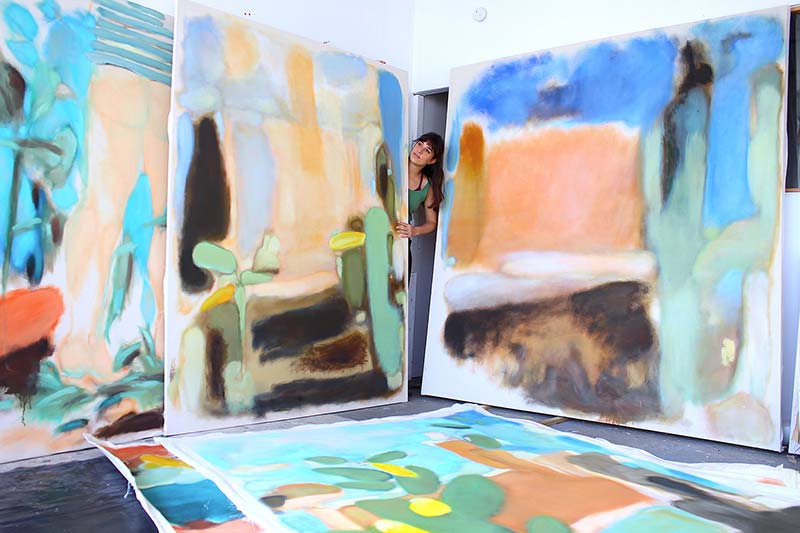Contemporary artist Juliette Sturlèse charts her journey across various countries and a shift from law to art, in pursuit of metaphysical painting.
Sometimes, feelings and sensations while painting become a flow that feels exciting and different; this is what I navigate with and what drives me to keep painting.
Contemporary artist Juliette Sturlèse
Featured image: Contemporary artist Juliette Sturlèse. In studio.

Contemporary artist Juliette Sturlèse.
Please tell us a little about yourself. What brought you to the world of contemporary art and how did you start?
My twin brother and I have always been surrounded by arts, music, and creativity in the family. We were born and raised in the French capital. Initially, I wanted to become a dancer and spent a lot of time in my childhood and youth doing ballet. In classes during school, I would be found drawing dancers and their movements, maniacally. The museums of Paris became my second home.
Later, my interest in concepts of society and justice led me to study law in Paris. Following a consequent number of randoms plans and encounters into bars and parties, I ended up distancing myself from France and Paris, and moved to Germany. Surrounded and inspired by other art students, I dumped everything to become an artist. After failed attempts, I entered the great Weissensee Academy of Art in Berlin. Meanwhile, I ended up living in several different countries abroad: Italy, Turkey, United Kingdom, and, of course Berlin in Germany. These varied places, humans and artistic encounters constantly feed my inspirations.

Autumnn spell. Contemporary artist Juliette Sturlèse.
Art has no didactics methods. It is an everyday statement of our presence on earth.
Contemporary artist Juliette Sturlèse.
What is the primary role of a contemporary artist? How do you describe yourself in the context of challenging people’s perspectives via your work?
If there is a role for an artist, it is to accept that they do not have a fixed role, and understanding the relativity of art. An artwork can be helpful to some people, but not for others. Contemporary art has no didactics methods. It is an everyday statement of our presence on earth. I am more a metaphysical painter rather than a descriptive or conceptual painter. I wish to transport people into an experience, over and above the simple visual description or intellectual idea, through sensuality; creating space and time in the minds of the audience for beauty and spirituality.

Romantic sunset on my survivalist garden. Contemporary artist Juliette Sturlèse.
I am defiant of concepts and ideas. They can quickly create blockages. You can only conceptualise what you already know.
Contemporary artist Juliette Sturlèse
How do you deal with the conceptual difficulty and uncertainty of creating work?
I am defiant of concepts and ideas. They can quickly create blockages. You can only conceptualise what you already know. Instead, I’d rather follow sensual and physical signals of the brain and the body, but not necessarily the intellect. Sometimes, feelings and sensations while painting become a flow that feels exciting and different; this is what I navigate with and what drives me to keep painting. I try to feel and see « wider » than myself, loosening controls, while still managing energies. Uncertainty is part of all of us. All that we know is that we don’t know.

Contemporary artist Juliette Sturlèse. Exhibition view at Reiter Gallery. Image courtesy of Reiter Gallery.
What would you call your style? Let’s talk about the evolution of your practice over the years. Tell us about your commitment to your current medium.
Complex. Simple. Rough. Delicate. Vibrant and intense colours on large raw-looking canvas. A big field of energy and vibrations which create oscillations between abstraction and figuration. Painting on very large formats helps me to lose myself into the canvas during the process. I am obsessively driven by colours and the painting medium. Oil paints are fantastic because of their intensity and subtlety. Unpainted canvas’s spaces in my work are like a breath, similar to spaces in the music or choreography.

In studio. Contemporary artist Juliette Sturlèse.
What inspires you? Let’s talk about your frameworks, references and process.
I work obsessively with the colours so that they become one with me. By that time, I can work more and more spontaneously. When I am in an interesting flow, my body knows which colour to put where, without having to think about it.
Let’s talk about your career, or if you prefer artistic journey. What were your biggest learning and hiccups along the way?
Taking criticism with a (very big) pinch of salt, unless it is a compliment! 🙂

Contemporary artist Juliette Sturlèse. Exhibition view at Reiter Gallery. Image courtesy of Reiter Gallery.
What are you looking for when you look at other artists’ work? Which shows, performances and experiences have shaped your own creative process? Who are your maestros?
I try to force myself to look at the works of other artists who have a different artistic perspective from my own, which I find very challenging. The Berlin art scene seduces me and inspires me for its wildness and freedom, I find the contemporary painting scene in Germany very exciting. I am inspired by the French painters who started modernism: Cezanne, Gauguin, Bonnard, and other great colourists. I love Monet’s paintings. I am also inspired by the American abstract expressionist, especially Joan Mitchell. The first time I saw one of her works, I was 17 and it was an energetic visual shock, even more so on realising it was painted by a woman. At that time, I almost rarely saw paintings in museums done by women. I felt so free and powerful while watching it. Made me think, ‘I want to be a painter’.

Des idees pleins la tete. Contemporary artist Juliette Sturlèse.
What is the best piece of advice you’ve received? Any mentor, curator or gallerist who deserves a special mention for furthering your journey?
A Berlin artist and ex-teacher during art school gave me the advice to overpaint a 6-meter long on a 2-meter high format I was painting for months, just two weeks before our first-ever student’s exhibition. It probably was a bit of silly advice but I did it. The rush forced me to work quickly and to trust more myself by not overthinking the painting. It was quite liberating.
Tell us about your studio, what kind of place is it? Could you describe your usual work-day?
Studio place is priority number one. There is a lot of daylight and my working hours tend to follow the daylight’s seasons. I try to be there on a normal Monday to Friday schedule basis with a lot of exceptions. I need a huge amount of energy to be able to paint, so if I feel physically tired I just observe my paintings or imagine them. Sometimes I just end up dancing in front of my paintings with music instead of painting. It is my kingdom of creativity and also of procrastination!

In studio. Contemporary artist Juliette Sturlèse.
What was your first sale?
My first sale was a still-life painting influenced by Giorgio Morandi from the time I lived in Bologna. I miss it.
How has the lockdown affected your practice and plans?
Lockdown has forced me to be more stable by staying in one place. Until now, it has been helpful for the creativity aspect, as everything went quieter and that allowed me to be more focused.
For enquiries contact : info [at] juliettesturlese [dot] com
Reiter Gallery, Instagram & Website
Before you go – you might like to browse our Artist Interviews. Interviews of artists and outliers on how to be an artist. Contemporary artists on the source of their creative inspiration.












Add Comment